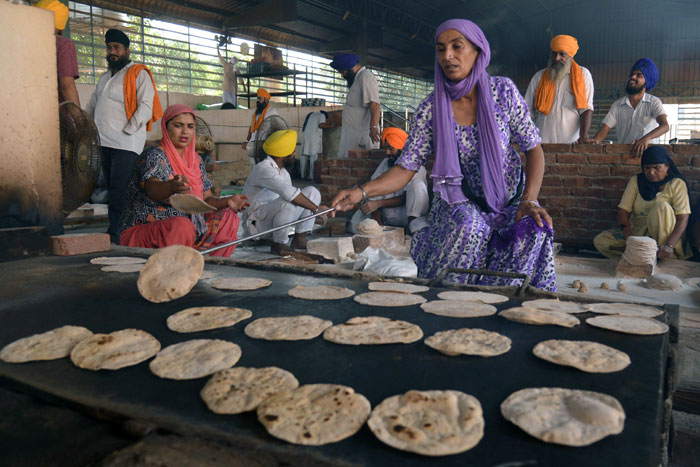Indian volunteers prepare food for flood-affected residents in Jammu and Kashmir state at a community kitchen at the Golden Temple in Amritsar on Sunday. The ready-to-eat meals will provide for some 100,000 people and will be flown from Amritsar to Srinagar daily.
AFP
Fresh rain in Indian Kashmir disrupted rescue operations on Sunday, a week after deadly floods struck the Himalayan region and then left hundreds of thousands marooned both in India and neighbouring Pakistan.
The floods and landslides have now claimed at least 480 lives in the two countries, and rescuers are struggling to cope with the scale of the disaster.
After a few clear days, more rainfall accompanied by thunder and lightning hampered relief operations in the worst-hit areas of Indian Kashmir's normally scenic and now devastated main city of Srinagar.
Floodwaters have been subsiding in recent days but desperate residents were still seen waving from rooftops and upper-storey windows of inundated buildings to try to attract attention.
In both India and Pakistan, security forces have been using boats and helicopters to deliver food and evacuate survivors.
"The weather is very bad. We have had to halt our operations for some time and we are waiting for the weather to clear," Indian Air Force spokesman Gerard Galway said.
"We are hopeful that we should be back to efforts as soon as the weather clears."
The Jhelum river, which breached its banks and flooded large parts of Srinagar on September 7, was feared to be rising again after fresh rain.
The new rainfall magnified the stench of death from animal carcasses, rotting vegetables, filth and overflowing drains. Health Minister Harsh Vardhan is set to visit the city on Sunday.
"The rains are making the pungent smell of dead animals, rotting livestock and other wastes even stronger. It makes your eyes burn, gives you a headache," Mehraj-Ud-Din Shah, chief of the Indian Kashmir State Disaster Response Force, told AFP by phone on Sunday.
Officials said it was too early to assess fully the extent of the disaster with many roads still impassable.
"It is going to take another three to four days to see the real damage. But right now, our biggest worry is about an epidemic breakout," O.P. Singh, director-general of the National Disaster Response Force, said in Srinagar.
"Many parts are still submerged in four to five feet of water and we are concentrating on supplying anti-diarrhoea, anti-infection medicines and using chlorine to avert diseases."
State administrator Syed Abid Rasheed Shah said the fresh rainfall also posed problems for scores of victims without proper shelter.
Shah told the Press Trust of India news agency that some tents were not waterproof, but he added that relief efforts would continue despite the rain.
In Pakistan, rescue operations on Sunday were concentrated around the central city of Multan, home to two million people, where authorities blew up two dykes to try to stop the water inundating the city.
"Multan is practically cut off from the surrounding districts: roads and railway track were submerged," Zahid Salim Gondal, a senior government official, said, adding that 29,295 people had been rescued.
Around the nearby city of Muzaffargarh, the flood has inundated some 300 villages, said Gondal.



